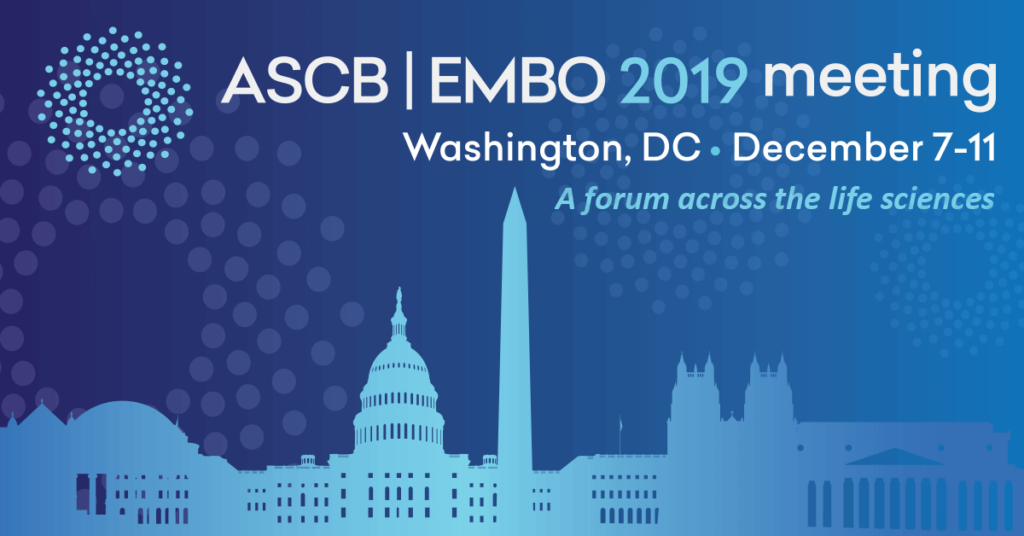The American Society for Cell Biology (ASCB) and the European Molecular Biology Organization (EMBO) once again have teamed up to produce the largest gathering of cell scientists in the world. The 2019 ASCB|EMBO Meeting takes place Dec. 7-11, in Washington, DC, and is expected to attract more than 6,000 cell scientists. Those interested in attending can visit the meeting website for a complete program, a full listing of abstracts, and registration.
“The ASCB|EMBO Meeting has everything: scientific diversity, professional development, the chance to see cool new methods and machines, a Doorstep Meeting, and the same sort of specialization you got in your small, manageable summer meeting,” ASCB president Andrew Murray of Harvard University wrote in a recent column about the event. Only the ASCB|EMBO meeting is on a much larger scale with a greater chance of making important connections. Clearly, a meeting of this size could not just have one theme. But the breadth and depth of that covered in reflected by the symposia featured.
“This year’s meeting features eight Symposia—sessions with talks given by leaders in fields that Elly Tanaka (Research Institute of Molecular Pathology in Vienna, Austria) and Sue Jaspersen (Stowers Institute for Medical Research, Kansas City, MO), and the Program Committee they chaired, picked because they represent cell biology’s most exciting areas,” explained Murray. “While many talks will cover topics similar to ASCB regulars such as the cytoskeleton and organelles, the Symposia were chosen to illustrate how cell biology is at the hub of fields as diverse as modeling and developmental biology, or biochemistry and genomics. Therefore, instead of giving them traditional titles, like ‘Cell biology of the cytoskeleton,’ we’ve tried to find something that better conveys how cell biology acts as an integrating theme for many areas of science.”
Symposia this year are titled, “Beyond Figure 7: Integrating modeling and experiment in cell biology,” “Attack of the Killer Bugs: The cell biology of infectious disease,” “Decisions, Decisions: How cells choose their fates,” “21st Century Machinery: The structure, function, and evolution of protein machines,” “What Blueprints Tell Us: How genomics informs cell biology,” “Getting from Here to There: Individual and collective cell migrations,” “Google Maps of the Cell: Controlling intracellular traffic flow and direction,” and “D’Arcy Thompson at 100: Controlling Cell Shape and Function.”
Minisymposia and microsymposia offer graduate students and postdocs the opportunity to showcase their work with talks reflecting the latest and most innovative research in cell biology across the globe. Poster sessions each afternoon provide another chance for researchers to gather organically to talk and exchange ideas. For the last several years, ASCB meeting organizers have been mingling the poster displays with the booths of the hundreds of exhibitors who attend each year. This creates a free flow of traffic for poster presenters and industry collaborators, government organizations, and publications.
Among the most popular events are the member-organized Special Interest Subgroups, which create a space where researchers take the lead, formulate a topic of keen interest, and invite selected speakers to expound on that theme. The focus of the Special Interest Subgroups ranges from particular problems, such as Bacterial Cell Organization and The Mechanics of Large Cellular Machines, to newly emerging techniques, such as Tools and Devices for Cell Biology and Machine Intelligence and Statistics in Cell Biology. Others, such as Building the Cell and Bottom-Up Cell Biology, cut across disciplines, facilitating connections between diverse groups of cell biologists.
In addition to the scientific portions of the meeting, the 2019 ASCB|EMBO Meeting provides chances for attendees to enhance and flex their professional development skills.
“ASCB and EMBO are deeply committed to helping individual scientists and scientific communities develop and grow,” Murray said. “At our joint meeting, we offer a wide variety of professional development activities designed to foster the growth of both individuals and groups. Career-focused workshops and hands-on sessions provide training and mentorship to people at all levels, with sessions on finding a graduate school, a postdoctoral lab, or a position in industry or academia; navigating through tenure; and how to write and review proposals and papers and produce more accurate and unbiased assessments of research and individuals competing for positions. Personal growth is accentuated by sessions on topics such as work-life balance and how to communicate with your boss.”
Other important highlights during or surrounding the 2019 ASCB|EMBO Meeting include the Doorstep Meeting (Dec. 7), which features the theme “Cancer: From Genomic Instability to Therapy”; and the one-day biotech mini-course (Dec. 6), which gives students interested in working in the industry some behind-the-scenes knowledge and job-hunting skills. The Keynote speaker for the 2019 ASCB|EMBO Meeting formal kickoff event on the evening of Dec. 6 is Bruce Stillman, President and Chief Executive Officer and William J. Matheson Professor of Cancer Biology at the Cold Spring Harbor Laboratory. A call for posters on the topic Scholarship of Diversity was new this year. And, the Public Policy Committee will host a first-of-its-kind Capitol Hill Day, where some meeting attendees will have a chance to meet with their elected members of Congress.
As far as Murray is concerned, the 2019 ASCB|EMBO Meeting is a must-do event. Due to the sheer number of ideas presented and the potential connections one could make, attending could very well change the course of one’s scientific career.
“Every time you see in your own research or hear in that of others something unusual, you have a chance to make a unifying connection with some other piece of knowledge and that connection can produce new ideas and push science forward,” Murray said. “But you can only make the connection if the other piece of knowledge, or something related to it, is already in your mental filing system. The more items and ideas there are in your relational database and the more diverse those objects are, the more likely you are to make exciting connections.”
Original post https://alertarticles.info
